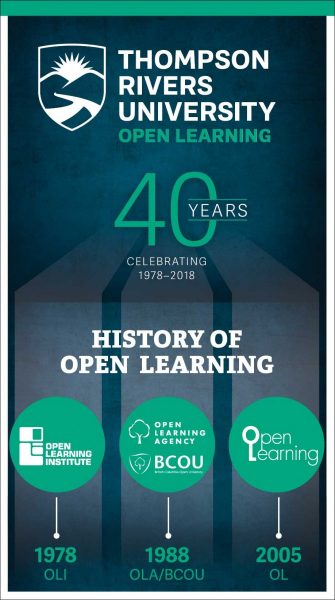
Open Learning celebrates its 40th anniversary
Forty years ago, there was no internet. The era of home computers and modern email was a speck on the horizon, and Moodle was but a twinkle in some developer’s eye. But there was Open Learning, and today—June 1—it celebrates its 40th anniversary of delivering flexible, accessible education to learners in BC and beyond.
On this day in 1978, the BC Colleges and Provincial Institutes Act, created the Open Learning Institute (OLI) to pioneer post-secondary education via distance. Through improving educational access for people in non-metropolitan areas, the government considered that it was making an investment in human capital and social development, which would in turn benefit the economic development of the province.
Thus, OLI was mandated to award its own undergraduate degrees in arts and sciences and to offer non-degree credentials, such as adult basic education (ABE) and upgrading. OLI also aspired to connect mid-career professionals with the opportunity to diversify their knowledge and skills while continuing their current employment.
Several Open Learning Faculty Members (then called tutors)—Ron Lakes, Gordon Rudolph and Rocky Mirza—have been with OL since January 1980. Alexander, who taught ABE and English, was one the 17 first hired in 1979. They shared some of their memories of those early days.
“For the first semester in fall 1979, there were only 760 enrolled students,” Lakes said.
By winter 1980, that number had increased to over 2,000—despite the lack of technological assistance.
“We had rotary phones and no computers,” recalled Rudolph. “All the courses were print and all were mailed to the students in what we called pizza boxes.”
Rudolph, teaching math, found that problematic.
“If I told students something during a call, there was always a chance they’d forget. Math is a visual subject,” he said. “It was like trying to teach art over the phone.”
The public perception about OLI and distance education was different then. Today, people are accustomed to receiving goods and services over the web, and even to meeting their potential spouse or employer online, but distance education was new and had a reputation to build.
“At Langara, where I was also teaching, a student was upset when he couldn’t get into a course. My colleague suggested he take an OLI course. The student replied, ‘But isn’t that just for people in jail?’”
Early in 1988, the Open Learning Agency (OLA), a BC Crown Agency, was established by legislation, combining the educational broadcaster Knowledge Network with OLI, which was composed of the Open College and the Open University and had separate administrative functions.
“Ron used to get paycheques from both the Open College and Open University,” Mirza said with a laugh.
Pioneering meant that paperwork was, literally, paperwork. Students had no choice but to mail their assignments, along with a triplicate form, to their tutors, who marked the assignments and mailed them to OLI, which would mail the assignments to the students. It could be weeks before students got their marked assignments back.
“No one complained about the delay, however,” Alexander noted. “Mail was a different animal then.”
In 1996, the educational components of OLA became known as BC Open University (BCOU) to include the concept of OLA’s partnerships with affiliated colleges (through its membership in what was then the Association of Universities and Colleges of Canada) to develop and deliver articulated degree programs. It was during this time that the institution first offered computer training to its tutors.
“I agreed to take the training but did so with reluctance,” Alexander said.
Mirza agreed. “The general feeling was, ‘All this work for a couple of students. Who’s going to use a computer?’”
On April 1, 2005, the Thompson Rivers University Act amalgamated University College of the Cariboo with BCOU to form Thompson Rivers University (TRU). All programs and courses became part of TRU under the newly created Open Learning (OL) division. In 2007, all OL operations relocated from Burnaby to TRU’s new BC Centre for Open Learning (BCCOL) building on the Kamloops campus, bringing with it thousands of distance and online learners.
Mirza said: “This changed my life. I used to go into the building (BCOU’s location on Mathissi Place) every few days. As for Ron, he practically lived there.”
Things have changed in other ways, too. The majority of courses are now offered online rather than in print, and most students need access to high-speed internet. Improvements include less time on the phone and far swifter turnarounds for assignments.
“There’s definitely increased communication and faster feedback,” Lakes remarked.
Over the decades, learners with certificates or diplomas have earned OL bachelor’s degrees. Full-time professionals with family commitments have obtained the credentials they need to grow their careers. Students have upgraded so they can enrol in university and access higher education from remote communities, major cities and all over the world.
OL made a difference, too, to students’ academic performances.
“I used to approve program plans,” Lakes explained. “Students who had done poorly in their first two years elsewhere would come to us. Now that they had matured and had family and career responsibilities, they were motivated to succeed.”
Alexander agreed. “They would do so much better than expected. Their GPAs would improve dramatically.”
Today, the number of OL students has grown to almost 15,000, approximately half of the university’s total enrolments. And Open Learning Faculty Members are proud of how they have supported academic success over the decades.
“We fill an important need; people can be doing something else entirely in their lives and still get a credential,” said Rudolph.
“There’s no barrier to entry. There are thousands of students OL has given a second chance to,” Lakes concluded. “What we do at OL works so well. And we can be proud of that.”

